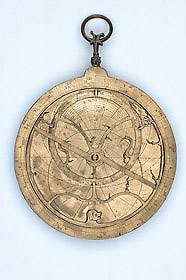
 |
| Catalogue |
 |
 Astrolabe 'Y' type rete for 18 stars, with a goat's head and tail at either end of the tropic of capricorn. The pointer for 'Alhabor' (Sirius, the Dog-Star) is in the shape of a dog's head; that for 'Wega' (Vega or the falling vulture) is shaped as a bird. The ecliptic circle has the names of the zodiacal signs, each with a scale 0 to 30, divided to 10, subdivided to 2, numbered by 10. Around the central pivot hole is a small disc with a scale of hours, 0 to 24, divided to 4, subdivided to 1, numbered by 4. Single plate engraved on either side and marked for 51 degrees and 51 degrees 34 minutes. Both have azimuth lines for every 15 degrees, unnumbered, and almucantars for every 2 degrees, with some numbered between 4 and 50. Meridian and east-west lines and tropics; lines for unequal hours beneath the horizon, numbered 1 to 12 by 1. The projection for 51? 32' also has a crepuscular line crossed by marks or dots. The back has a zodiac and calendar scale, with the signs named and each allocated a 30-degree scale divided to 5, subdivided to 1, numbered by 10, and the months named (abbreviated as appropriate) and divided to 5 days. The central space has a double shadow square, each quadrant with scales 0 to 12 to 0, divided to 2, subdivided to 1, with only one quadrant numbered by 4. Above the shadow squares is an incomplete semicircular scale. Counterchanged alidade with slit and pinhole sights, pin, and counterchanged rule marked with positions for the tropic of cancer and the equator. The wedge is a modern replacement. Jim Bennett |



